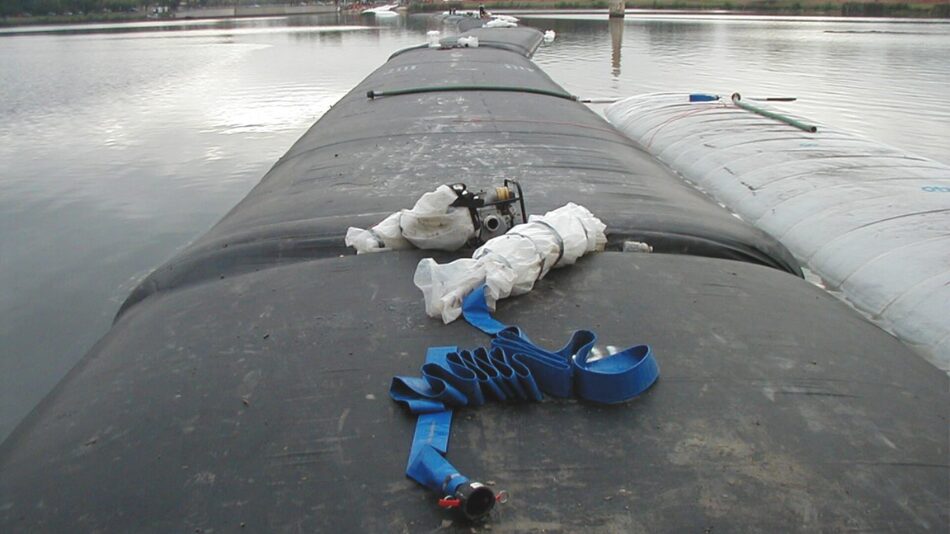
A total of 1,400 feet of Woodlawn Lake in San Antonio, Texas was successfully crossed using a combination of AquaDams of varying sizes. The primary AquaDams were reinforced with smaller dams to effectively withstand the pressure exerted by the water depth. To safeguard the aquatic life and conserve water, workers strategically partitioned the lake while a section of it was drained for necessary repairs. The accompanying photo showcases a seamless connection achieved with the use of a connection collar.

Before the installation, the lake depth was decreased by utilizing several large 6-inch water pumps. Lowering the water level prior to installing the AquaDam® helps to minimize costs associated with the unit. The AquaDam® was strategically positioned at the top of the bank and then gently rolled down into the water. Subsequently, it was filled with water using four 3-inch pumps, with two pumps allocated per fill-tube.
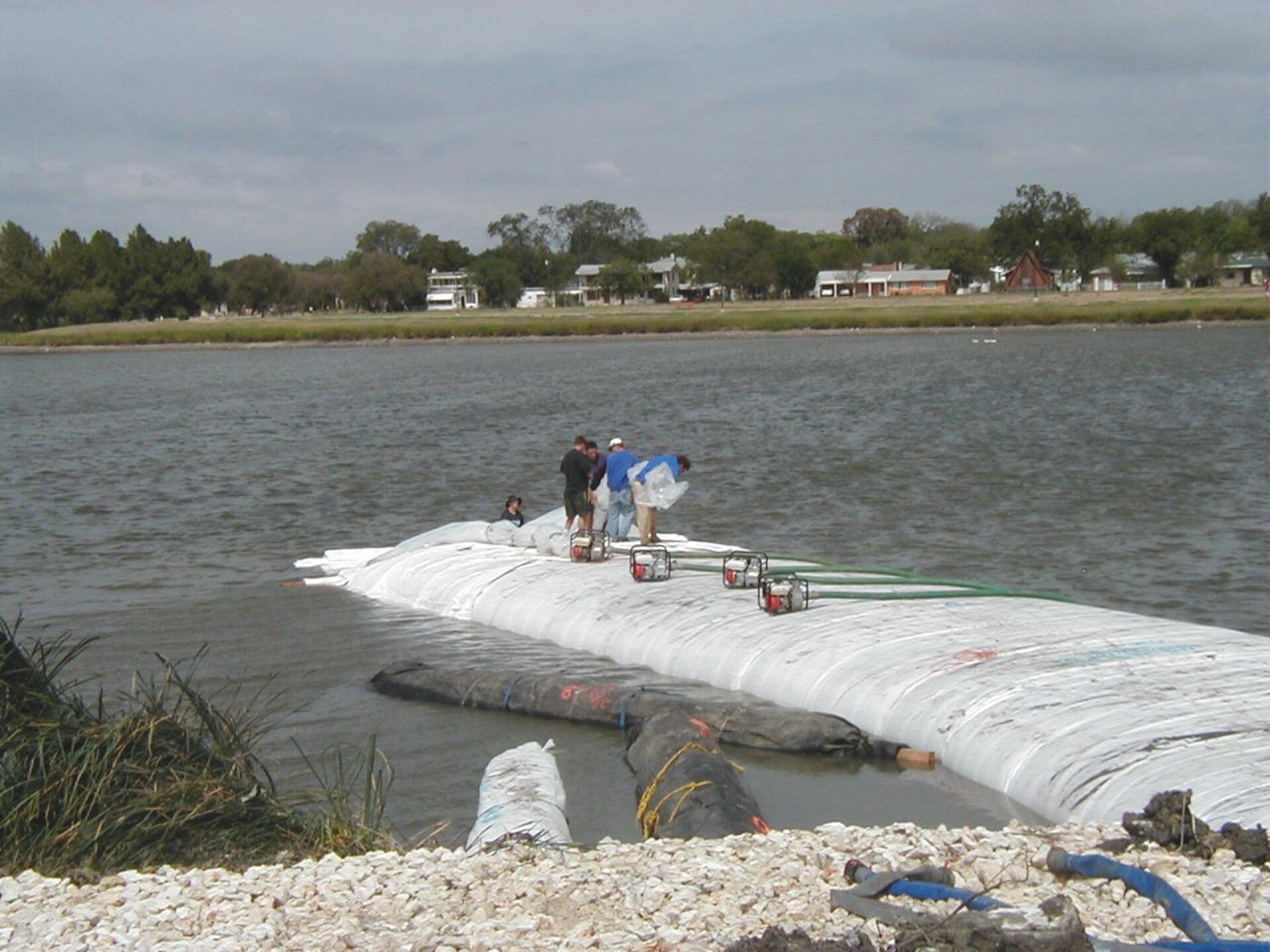
After the first AquaDam® was mostly filled with water, the pumps were moved out onto the it so that the next AquaDam® could be connected and filled with water. The next three AquaDams to be installed are still rolled up and can be seen floating in the water. AquaDams are delivered in a rolled-up form, similar to a carpet roll on a wooden beam. They are wrapped in a protective covering and include lifting ropes or straps for easy transportation. This project utilized fourteen 100ft long AquaDams, most with connection collars to complete the crossing and isolate the shoreline.

Due to the severe drought in this region of Texas, the lake depth was already significantly low. These conditions made the installation of AquaDams a straightforward process, as the lack of strong currents made it easy to position the dams correctly. The only potential challenge was the wind, but any drifting AquaDams were promptly corrected using a jet ski.
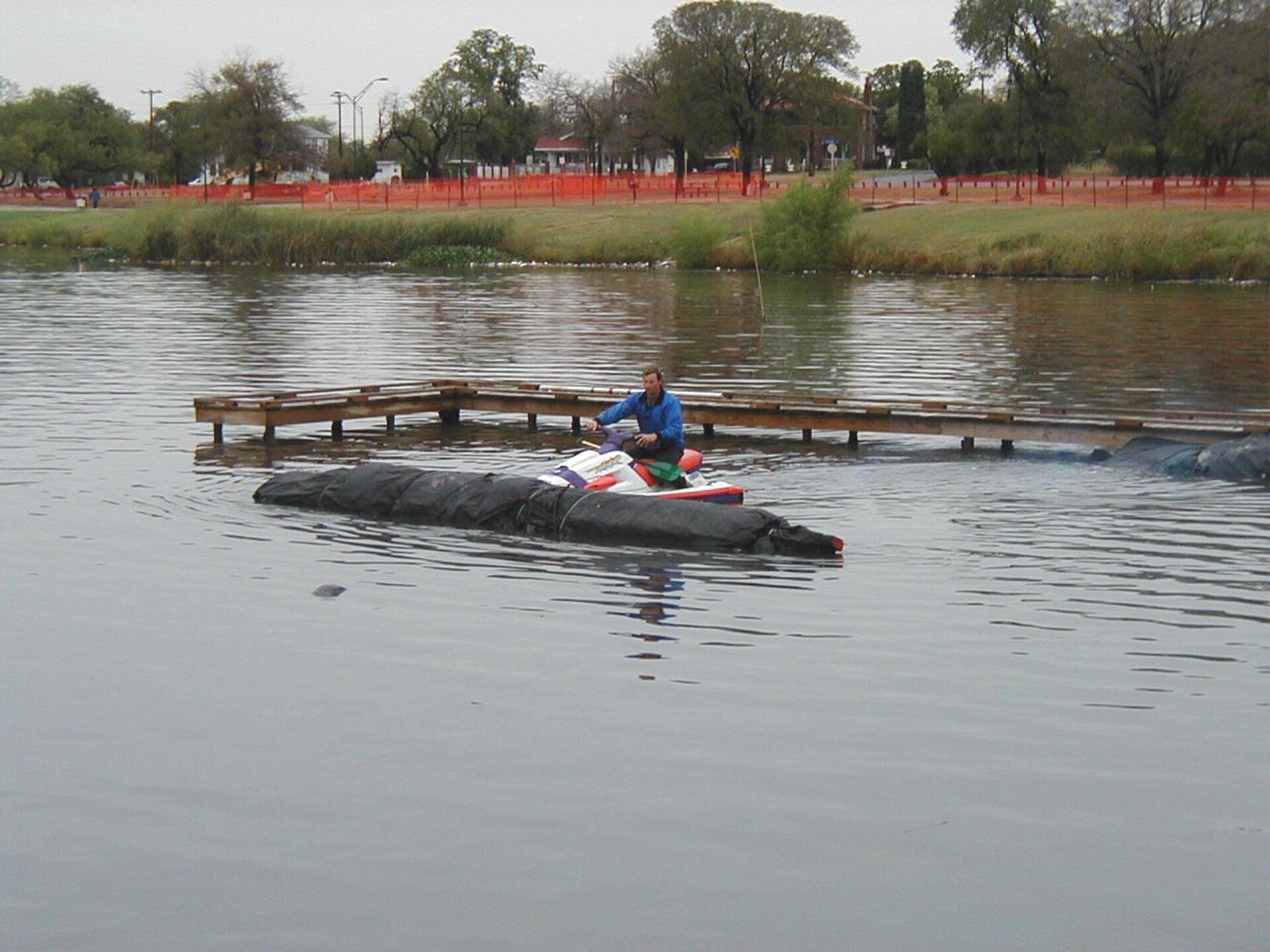
In deep enough water, a jet ski is essential for quickly positioning AquaDams. An alternative method is to manually pull the AquaDam® through the water by tying a rope around it from either the shore or the top of an installed AquaDam.
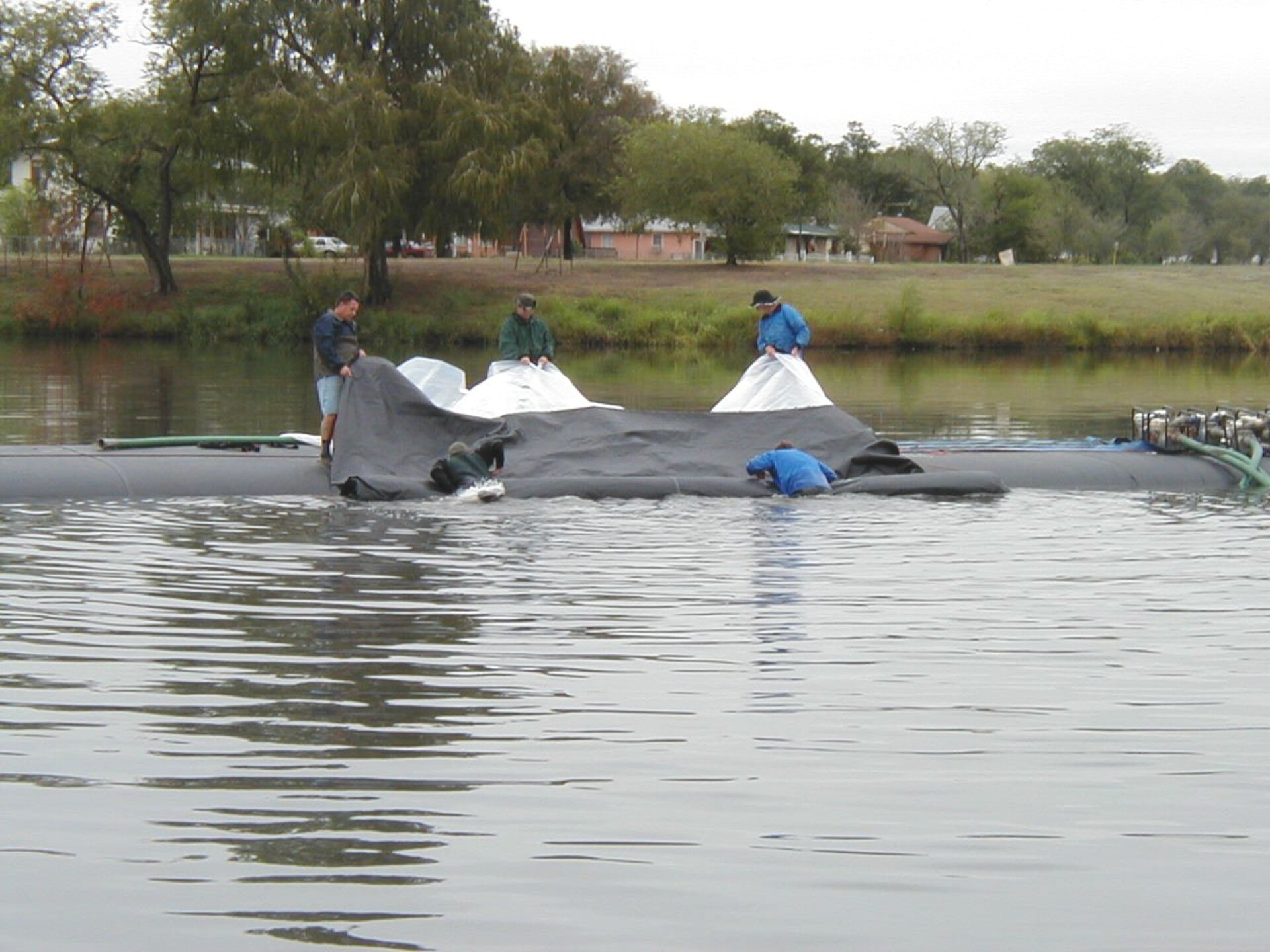
One team of workers stands atop the AquaDam, holding the open end and fill-tubes, while another team partially unrolls a few feet from the roll end. The workers holding the fill-tubes will pleat, group, and secure both of them into a four to six inch wad. This method facilitates the insertion of fill-tubes through the holes in the collar during the connection process. The unfilled single closed end (SCE) AquaDam® was floated to the closed end and attached to the AquaDam® on which the workers are standing, using a connection collar.

SCE AquaDams with connection collars have been started from two opposite banks and will meet in the middle of the lake to make a continuous water-filled cofferdam, and divide the lake in half. To ensure proper installation and functionality of a SCE AquaDam, it is essential to have a starting bank that maintains a higher elevation than the body of the AquaDam. The open end and fill-tubes of the SCE AquaDam® must remain elevated above the full height of the dam along its designated path. It is important to note that an AquaDam® will only reach its maximum height at the lowest elevation point along its designated path. Check out the miniature light house in the upper right-hand corner of the picture.
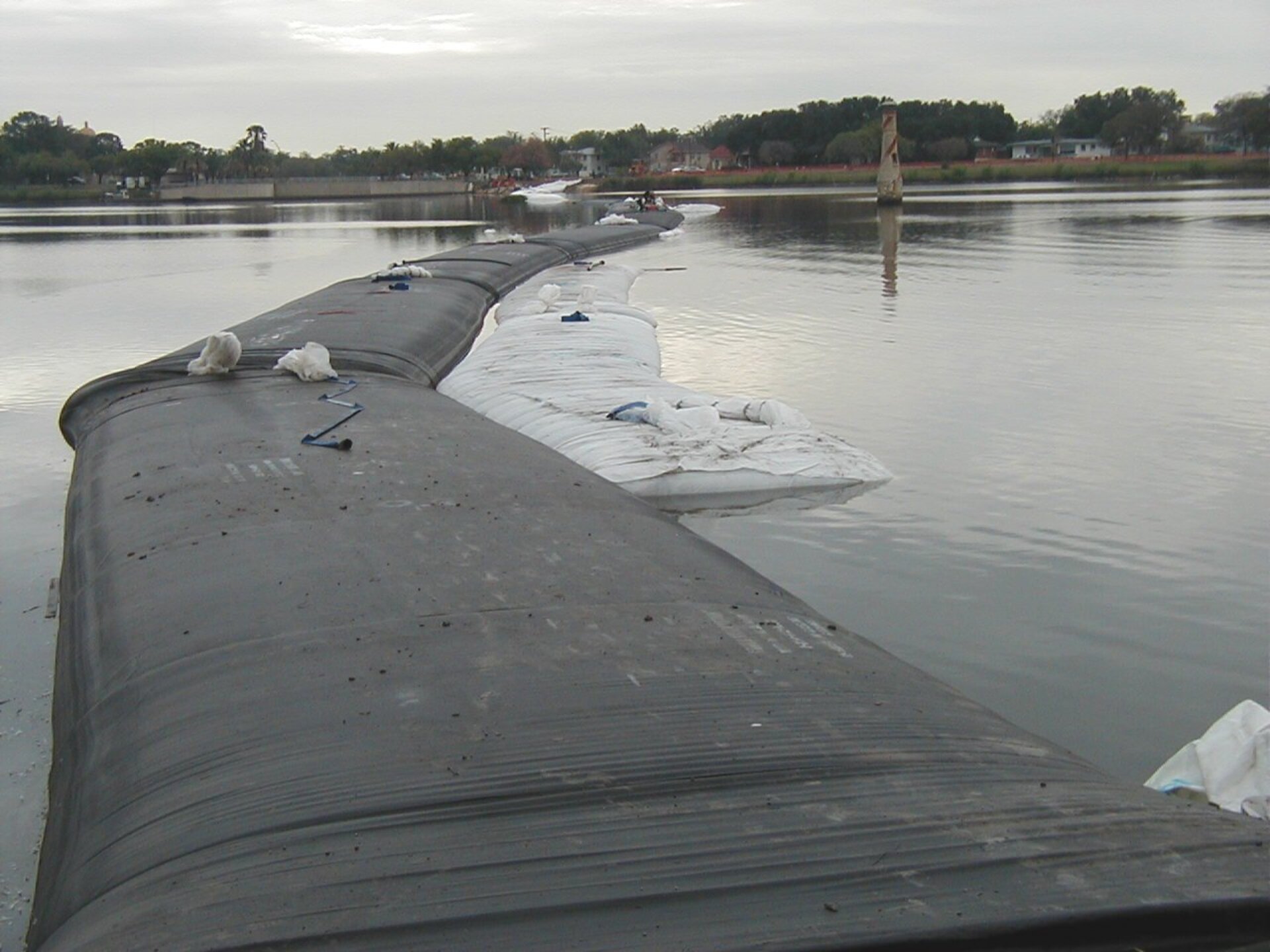
5ft tall AquaDams were used to support the 6ft and 8ft tall main AquaDams. The white support AquaDam® is a double closed end (DCE) unit that had two connection collars. The two collars allowed AquaDams to be attached to each of its closed ends. This type unit is typically referred to as a "plug". A DCE AquaDam® does not need to start on a bank because its fill-tubes are extruded out atop of the unit.
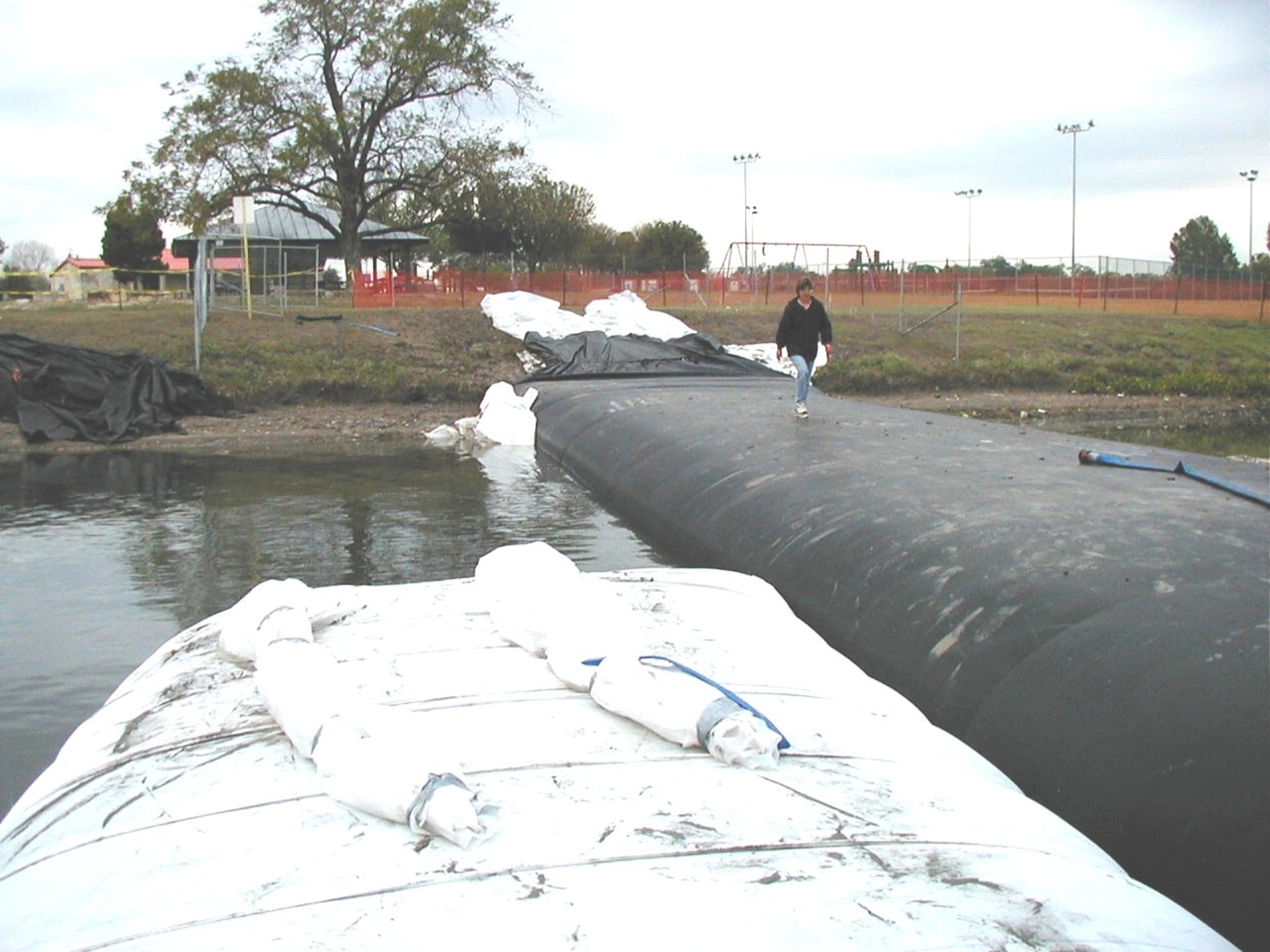
Any water that may have seeped under the larger AquaDams was trapped by the support dams and could be pumped out. This technique worked well for supporting the main, continuous, water-filled cofferdam.

In regions with shallow water, workers were able to stand inside the attachment collar, facilitating the connection process. To prevent water buildup and ensure stability, the fill-tubes are secured with small diameter rope. This measure prevents the tubes from becoming too heavy and pulling down off the top and over the side, which could result in water drainage.

This is looking across the lake at the fifth connection of 8ft tall 17ft wide 100ft long SCE AquaDams all joined together with connection collars. These AquaDams were initially installed in a deeper part of the lake. However, due to an elevation rise in the lakebed, the water now only reaches waist-deep. This allowed the workers to comfortably stand while attaching the next AquaDam.
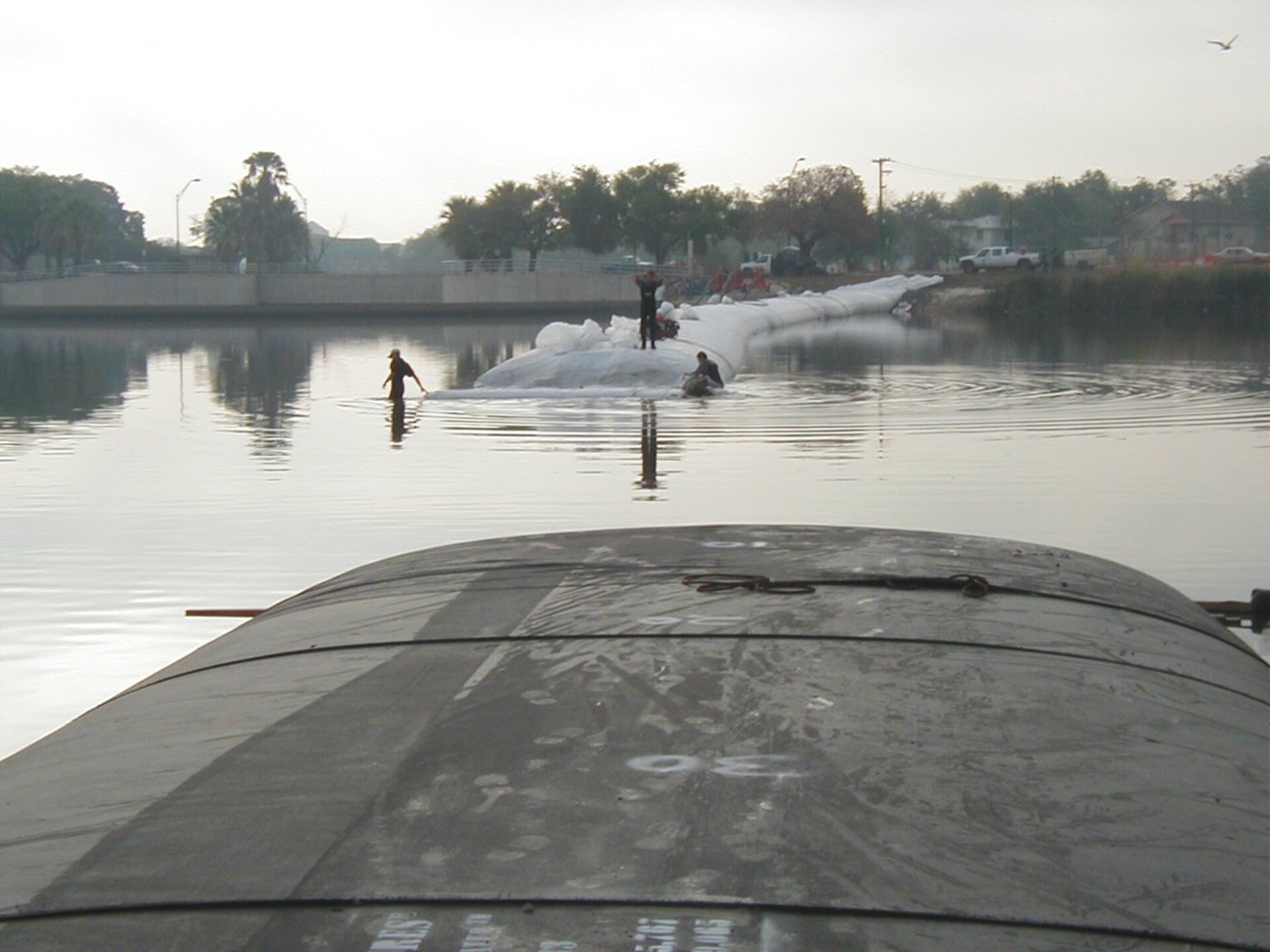
Workers are just 130 feet away from completing the final connection in the middle of the lake. Once this connection is made, support dams will be installed alongside the main AquaDams to prevent sliding on the muddy, slippery lake bottom in the de-watered area. This additional support will ensure the stability and effectiveness of the AquaDams throughout the project.
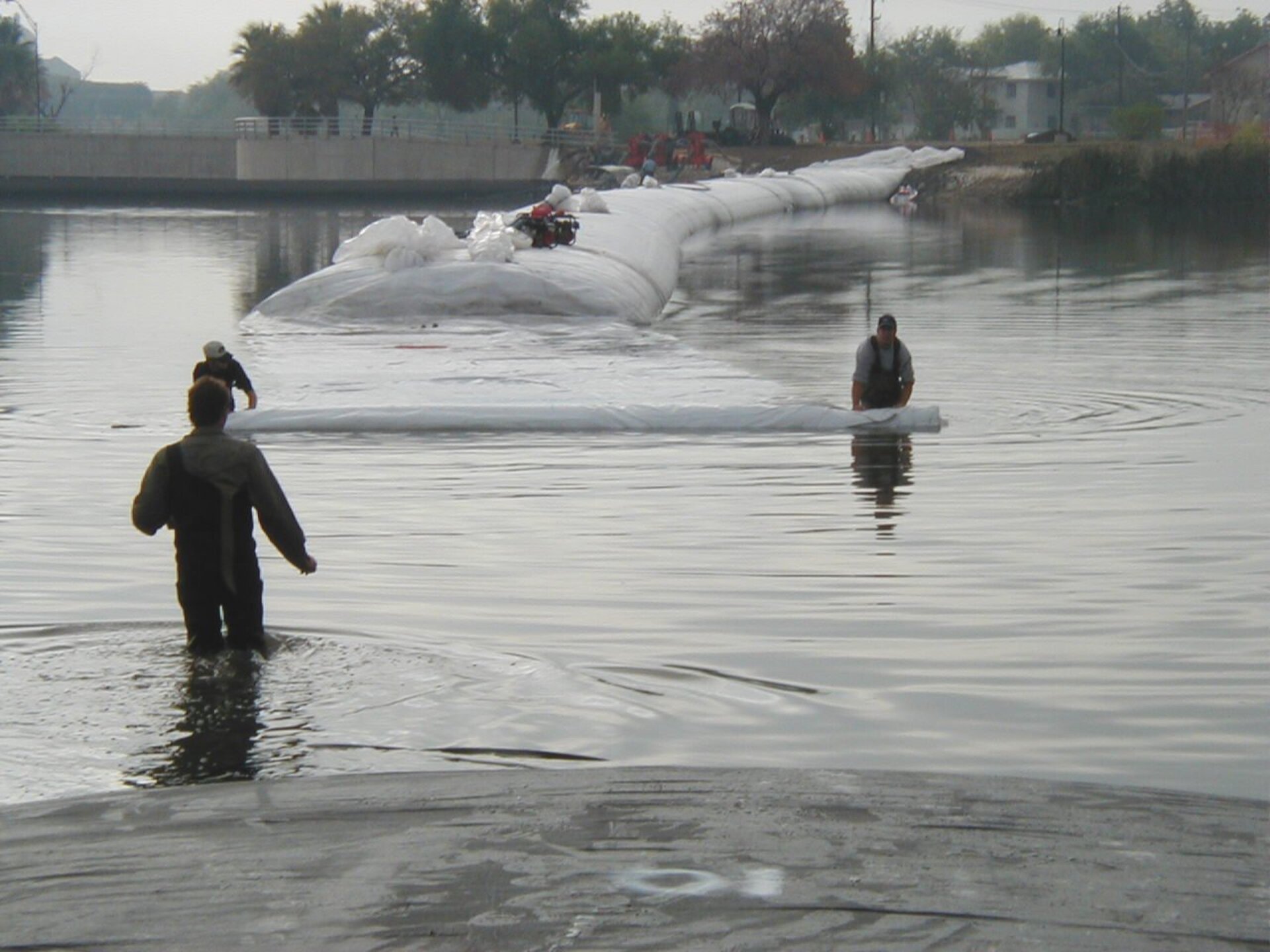
The water depth in the lake was shallow, only reaching knee-deep at the location where the final connection needed to be made. While smaller AquaDams could have been sufficient for the job, the contract specifically called for the use of larger AquaDams. The unrolling 100ft long segment seen in this photo took approximately three hours to install and fill.

The AquaDam® cofferdam system has been successfully installed, with all support dams in place and de-watering operations already in progress. Take note of the miniature lighthouse now visible on the left side, surrounded by a drained water area revealing a mud flat. Workers have erected an orange screen to prevent fish from entering a sump hole and being drawn into the pump.
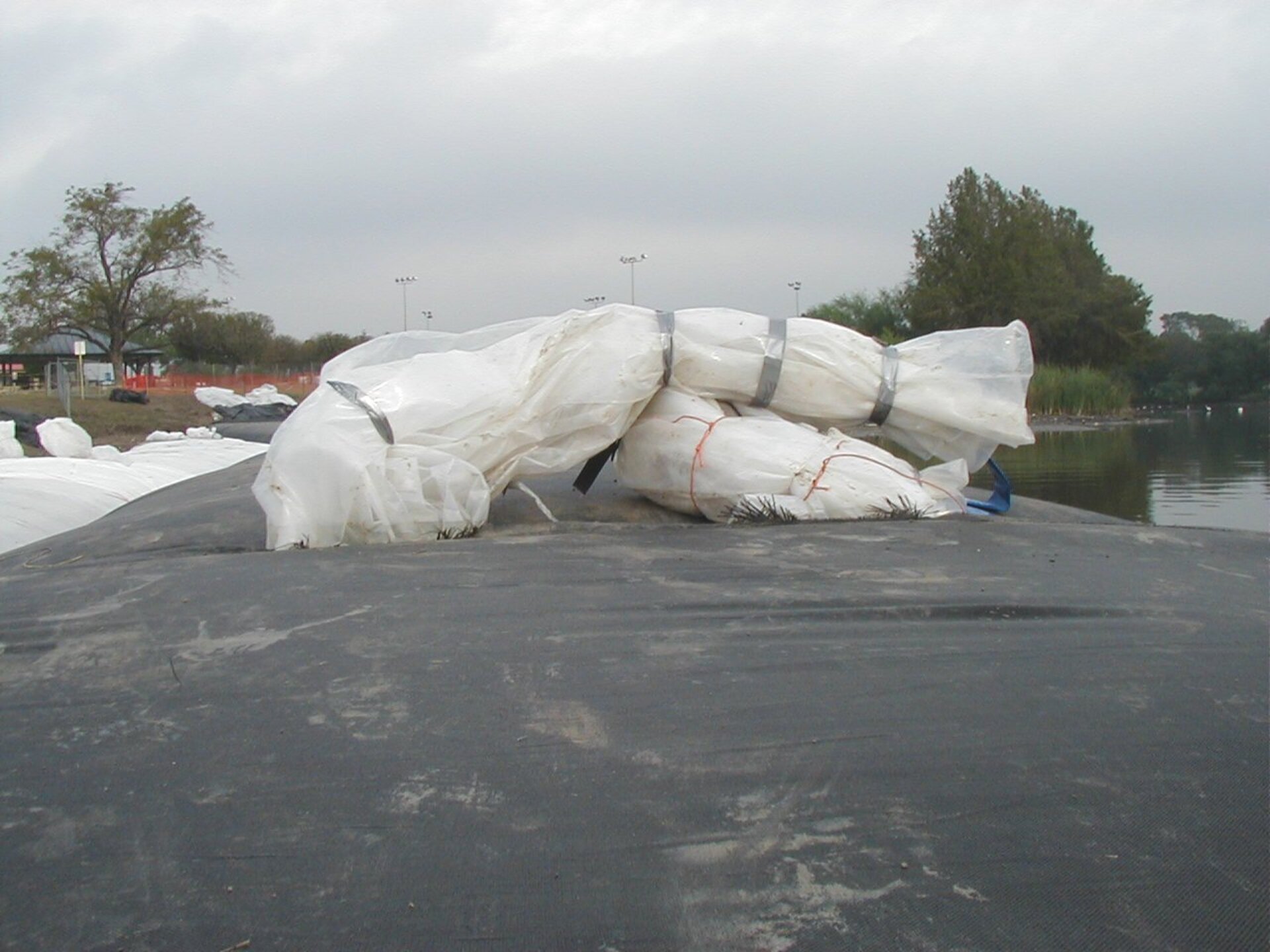
These are the fill-tubes of a SCE AquaDam® sticking out of a connection. Both of the fill-tubes extend out through the connection collar. The open end is laid out atop the closed end inside the collar. The attached segments look like one continuous tube, making a watertight seal, because of the internal pressure of the AquaDams.
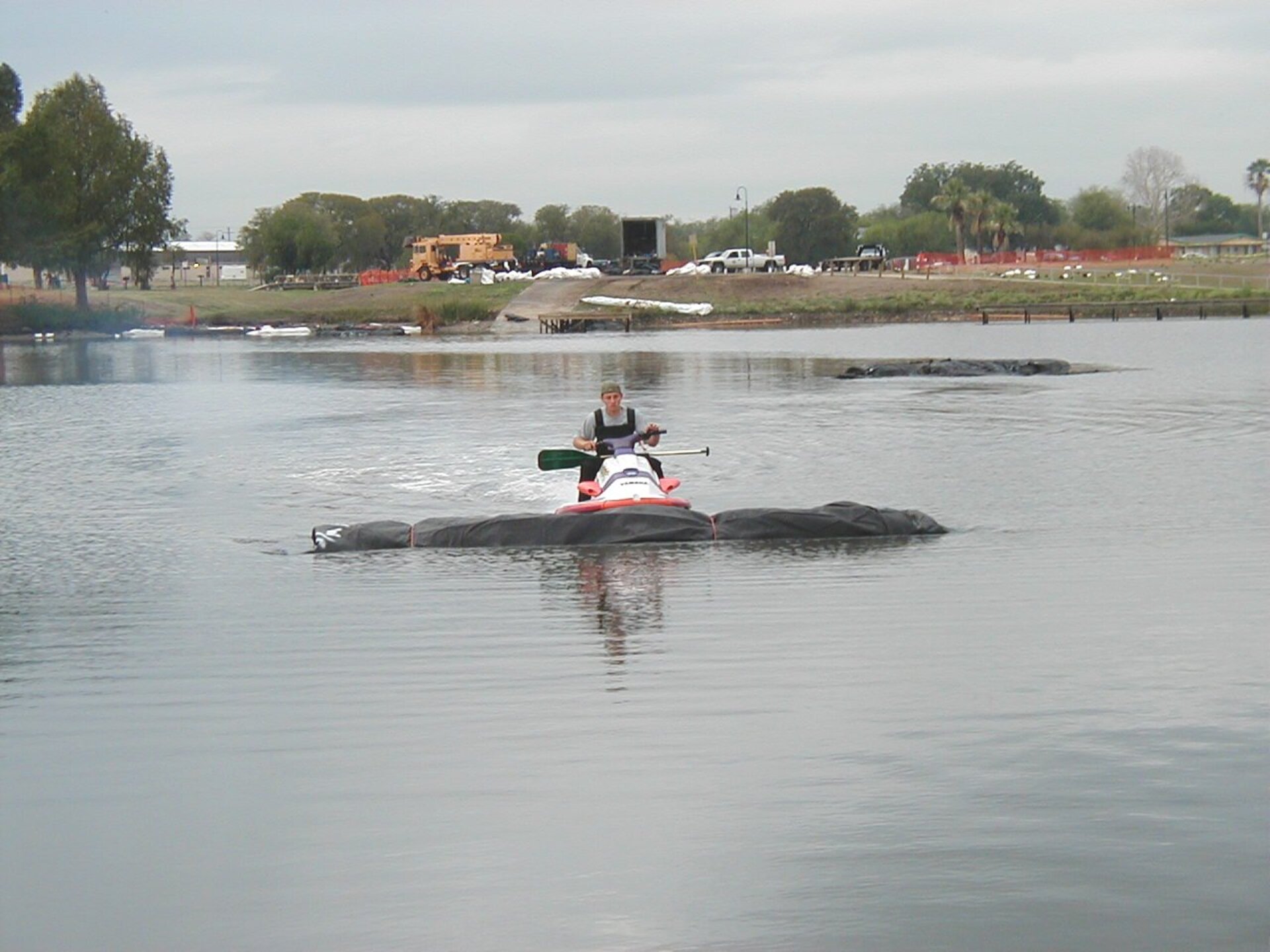
A worker is transporting a rolled-up AquaDam® from the shore to the end of the cofferdam. This task was efficiently completed with the assistance of personal watercraft. The jet skis were also utilized to transport workers and equipment across the lake. Safety is paramount, as life vests are always required, despite the water depth being a maximum of only 5ft.
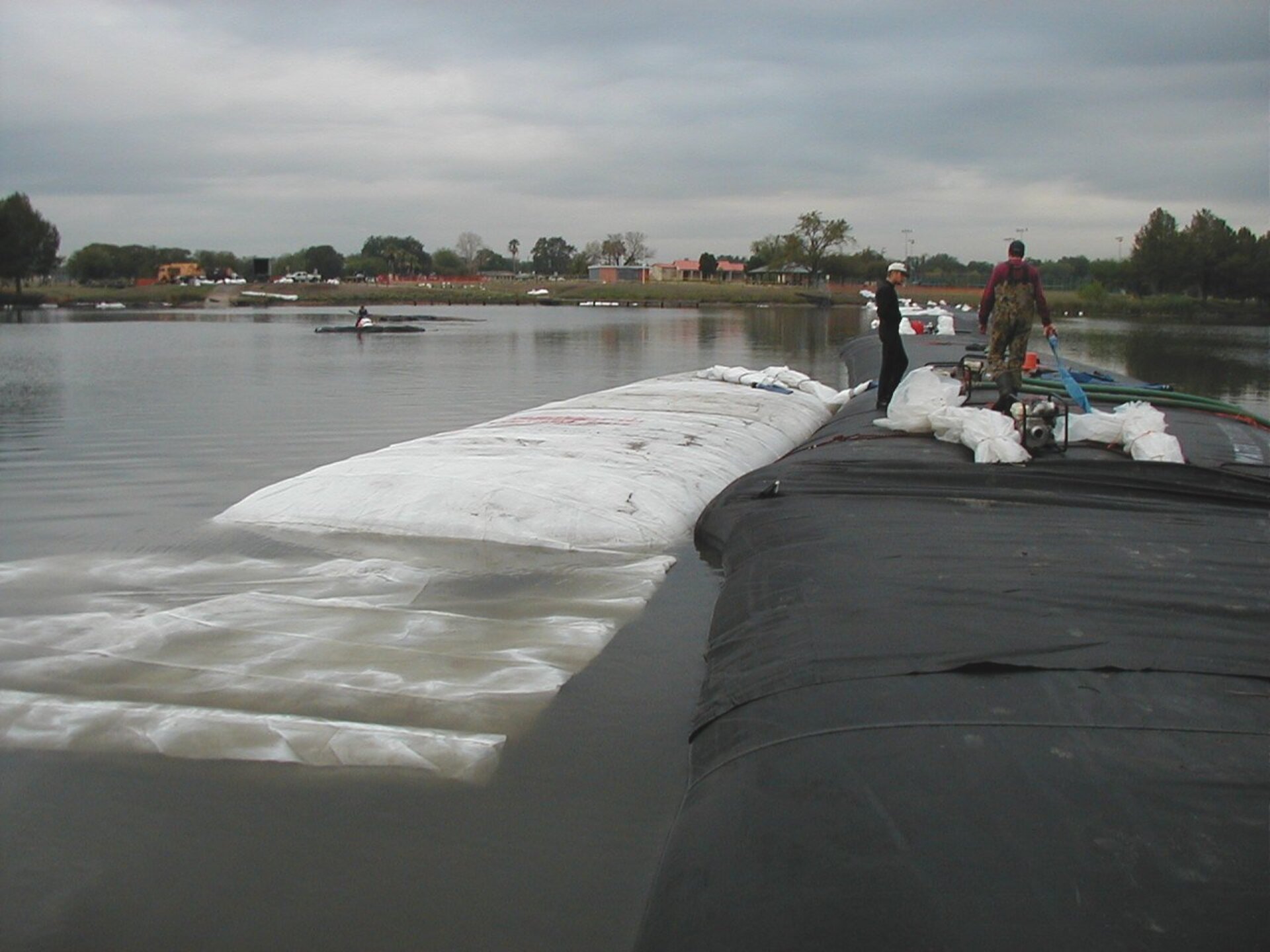
One half of the connection collar is visible floating in the lake, while the other half is located around the last 15ft of the closed end of the filled AquaDam. Both components are white, making it difficult to distinguish the outside skin of the AquaDam® from its collar.
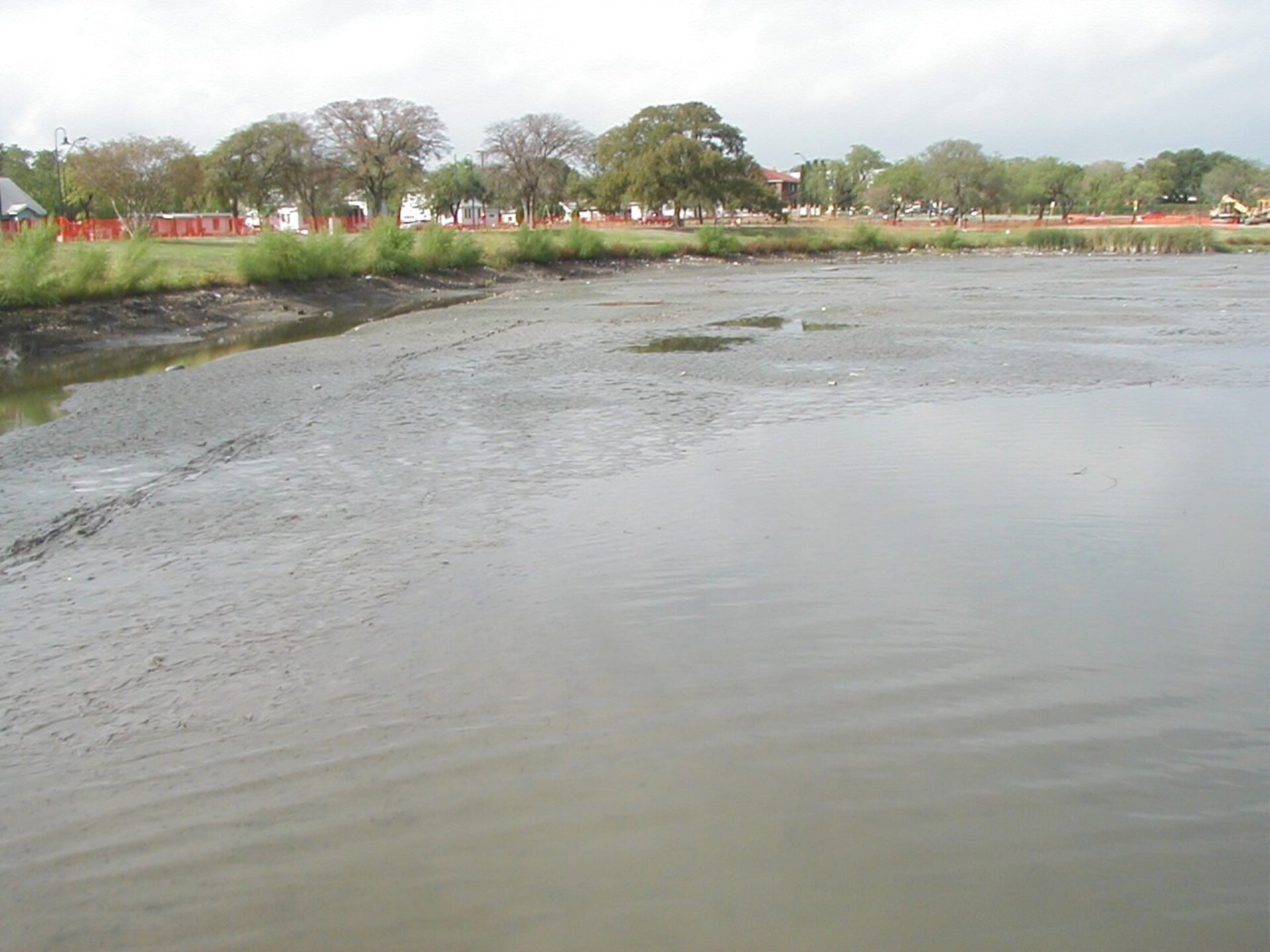
You can see the exposed mud flat after de-watering the shoreline. After initial de-watering, only one pump, left on idle, was used to keep the water completely drained off to allow for excavation and removal of built up sediment.
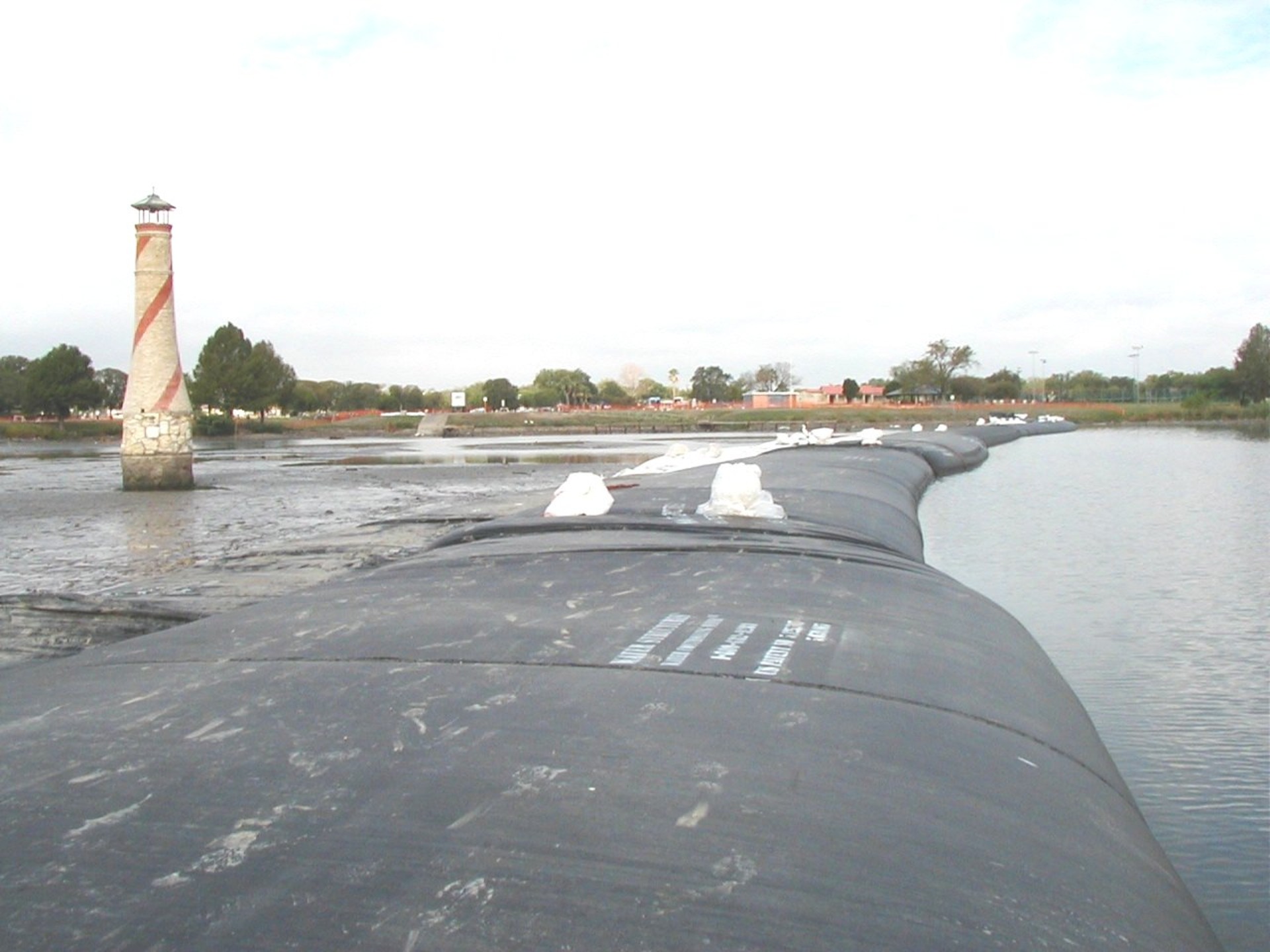
Overview of the de-watering. Can you see the water depth difference from one side of the AquaDam® to the other?

Overview of the work area de-watered, from shore.
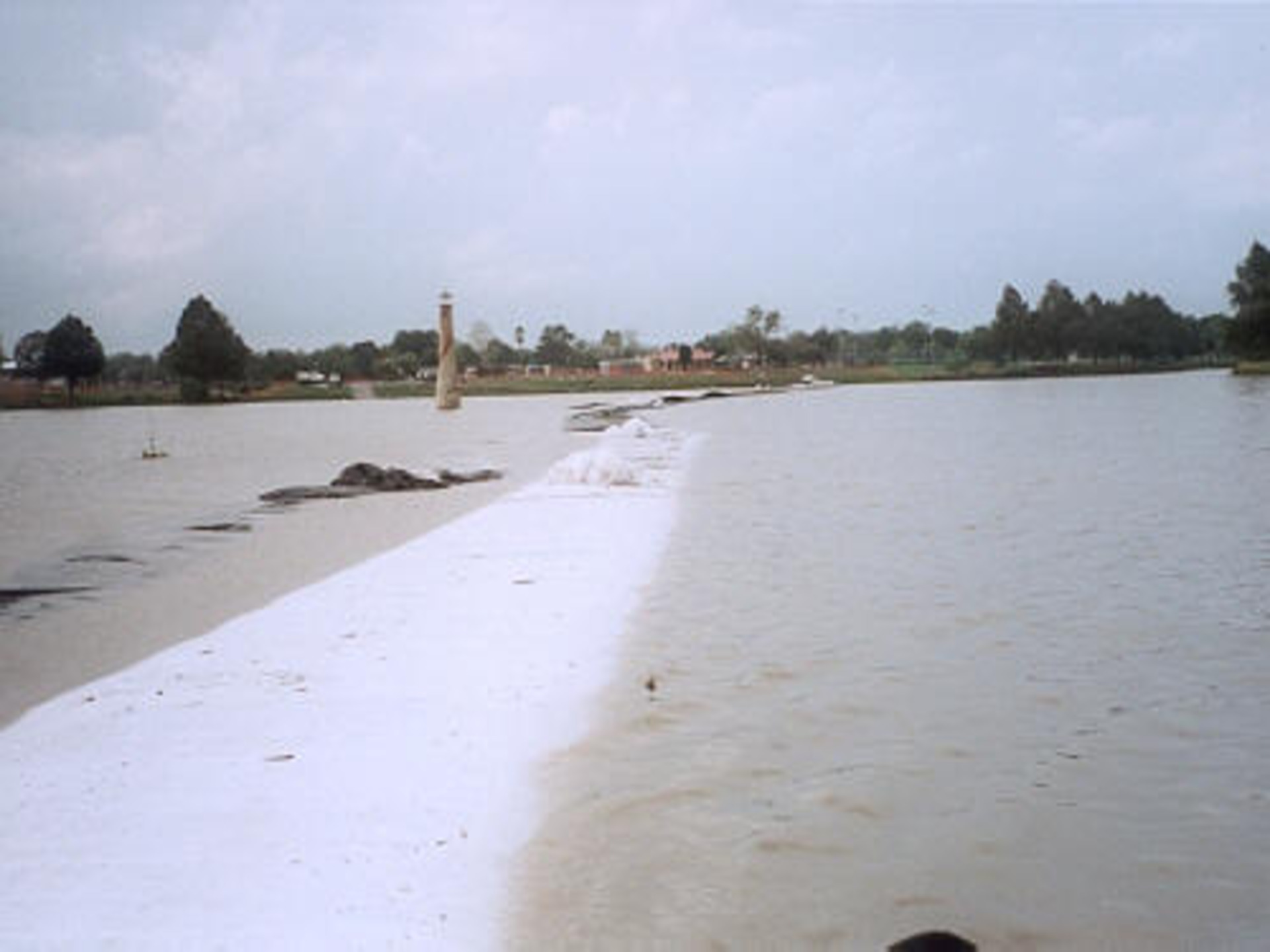
This project was initially postponed during the dry season, which is typically the ideal time for construction to take place. However, construction finally commenced in November. Despite the fact that the total rainfall for the previous six months had been less than one inch, a sudden thunderstorm occurred just one week after the AquaDams were installed, resulting in over an inch of rain falling within a span of two and a half hours.
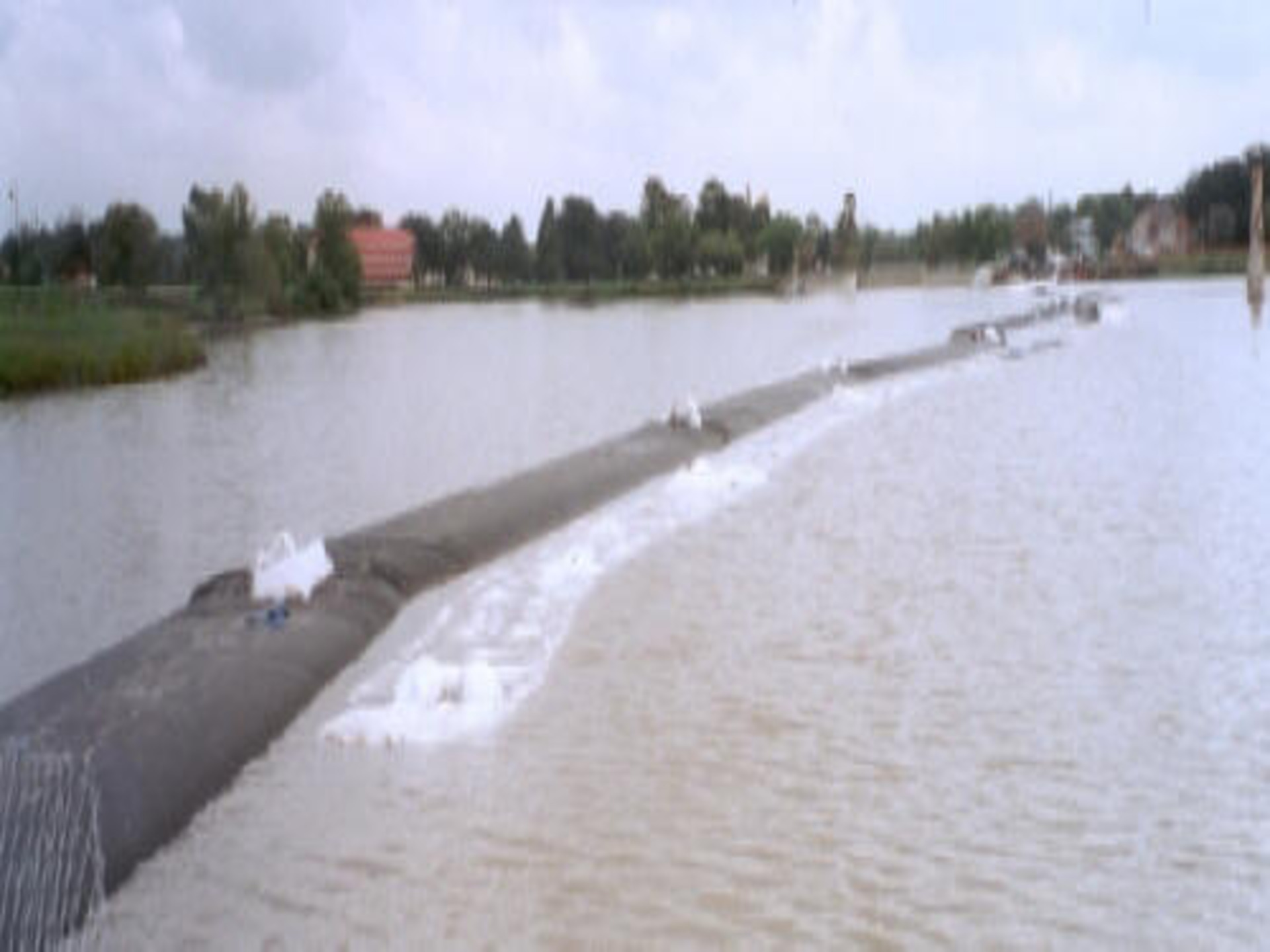
More than 35 square miles of the greater San Antonio area flow into this lake. Despite receiving only an inch of rain, the water depth in the lake increased at a rate that exceeded the capacity of the workers' pumps.
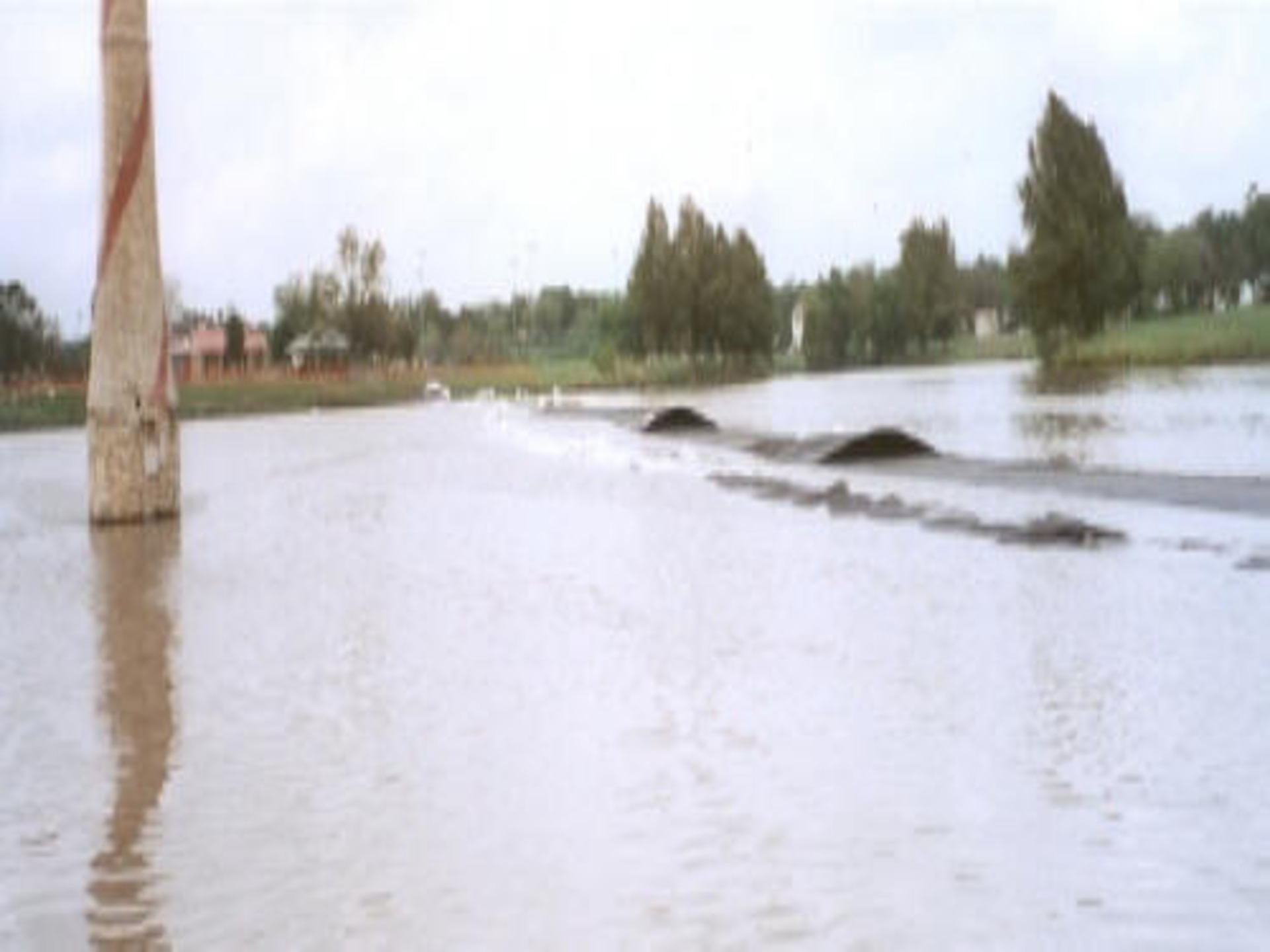
The AquaDams were overwhelmed by an additional 4 feet of water, causing them to wash out and become misaligned. This can be clearly seen in this photo. The AquaDams were left floating freely on the flooded lake.
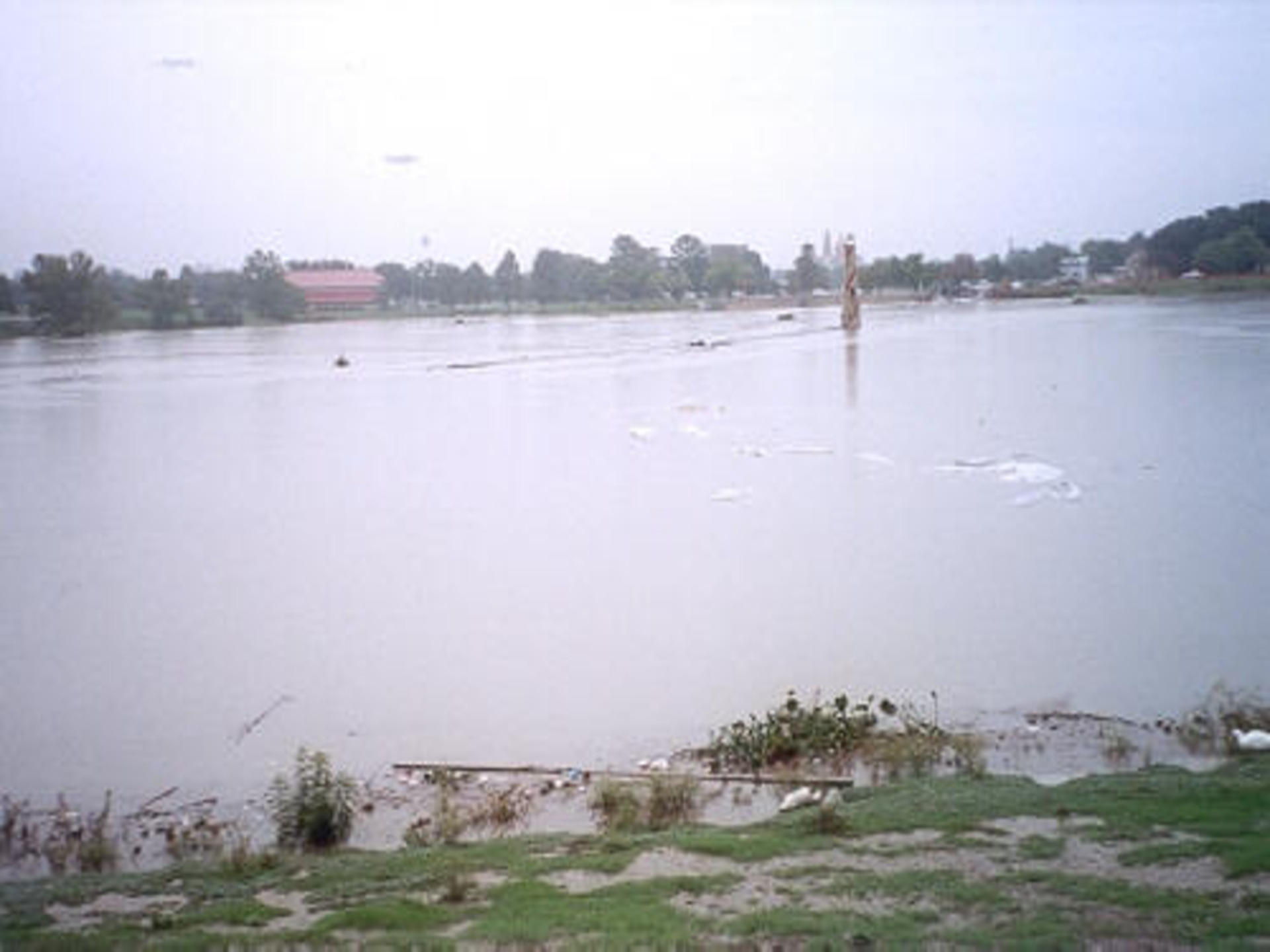
The water depth in the photo is approximately one foot above the overflow dam of the lake. The boat dock of the lake is located in the foreground of the picture, but it is not visible as it is submerged underwater. The AquaDams have proven their effectiveness as they prevented the deposition of earthen fill materials on the lake bed, despite being washed out due to unexpectedly high water depth from the thunderstorm.

The structure behind the workers is the overflow for the dam that creates the lake. Water is spilling over the top, and its volume increased dramatically immediately following the thunderstorm. The workers' pumps were unable to keep up with the rising lake level, resulting in many AquaDams being washed into the overflow and damaged. It is advisable to avoid working in water during the rainy season to prevent such incidents from occurring.
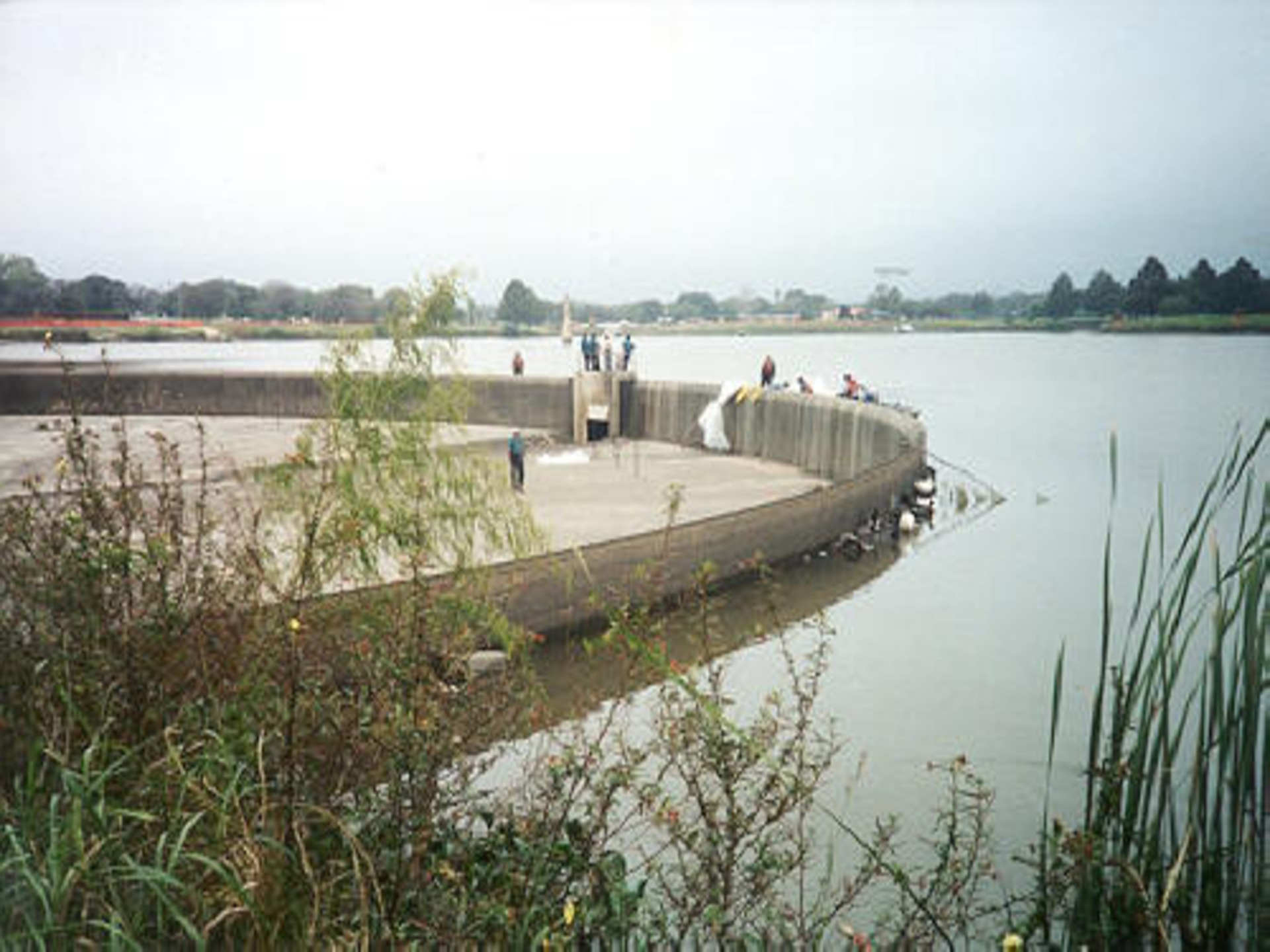
A second project has been initiated to repair the built-in drainage door in the cement overflow of the dam. There is uncertainty surrounding the functionality of the door once opened, as it may result in the complete drainage of the lake. This repair is essential for regulating the water depth in the lake without the need for pumps. Pumps will only be utilized for de-watering the work area.
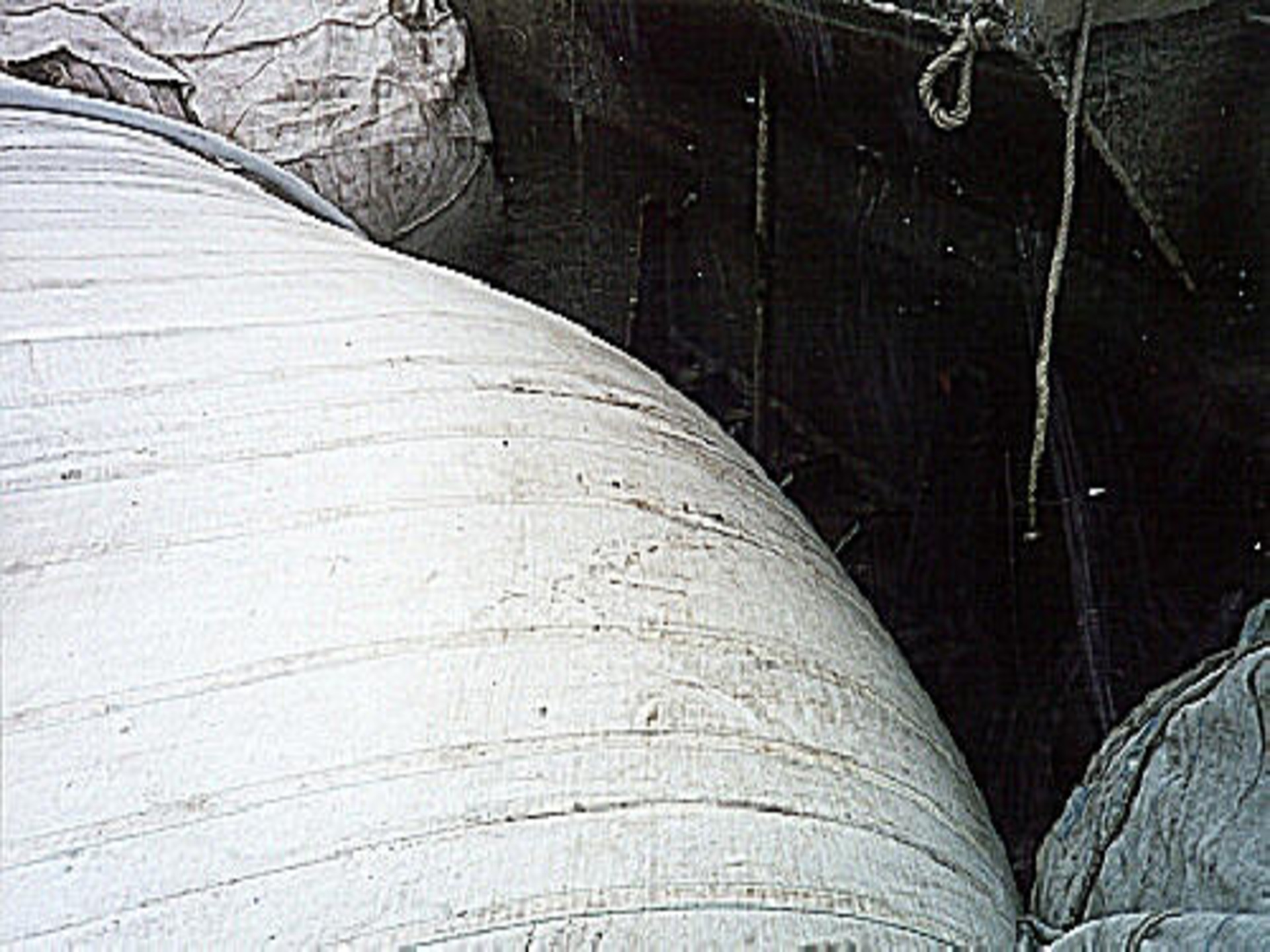
This time an AquaDam® cofferdam system was installed in a horseshoe/”U” shape configuration around the door. This configuration allowed for the inspection of the door without draining the lake. Subsequently, it was discovered that a rubber seal required replacement in order for the door to function correctly.
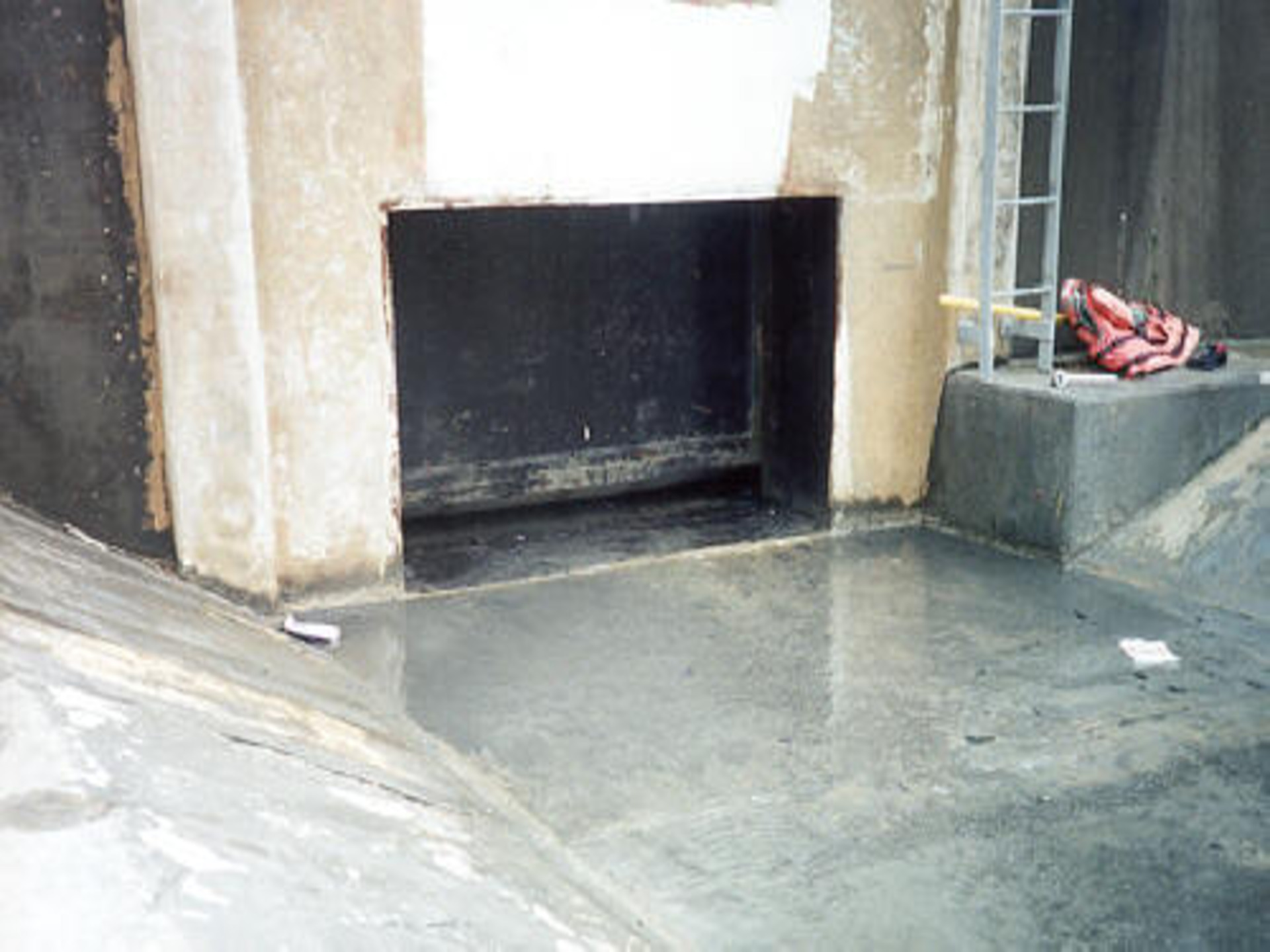
This is a perspective of the door from within the spillway. A wheel positioned at the top of the overflow enabled the door to be raised or lowered. By opening the door, a significantly larger volume of water could be efficiently drained from the lake in a shorter timeframe.
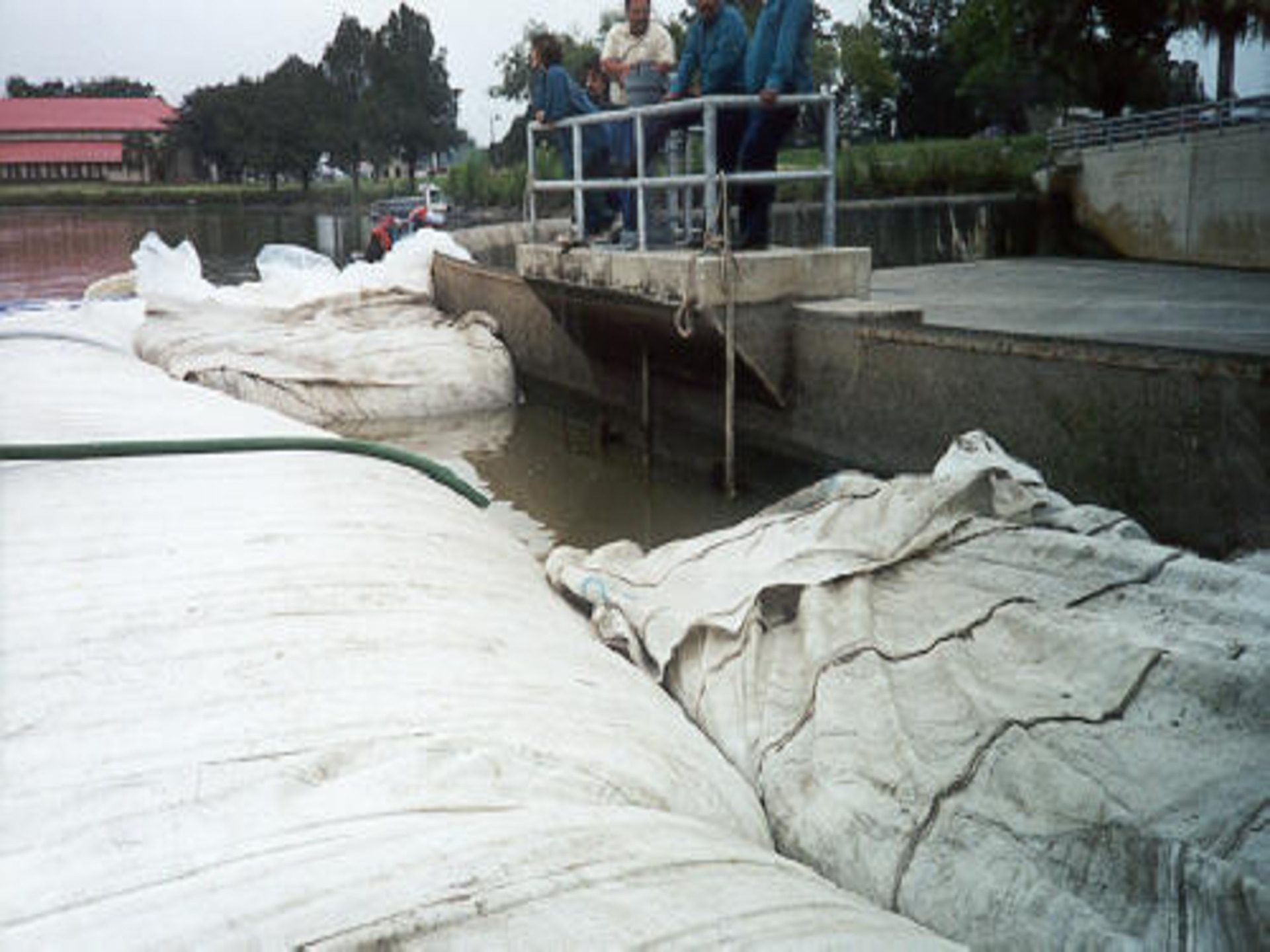
This shows the configuration of the AquaDam® cofferdam system in front of the concrete overflow. After several days of pumping, the lake water was lowered to a depth of 7ft in front of the doorway. This picture was taken before de-watering in front of the door.
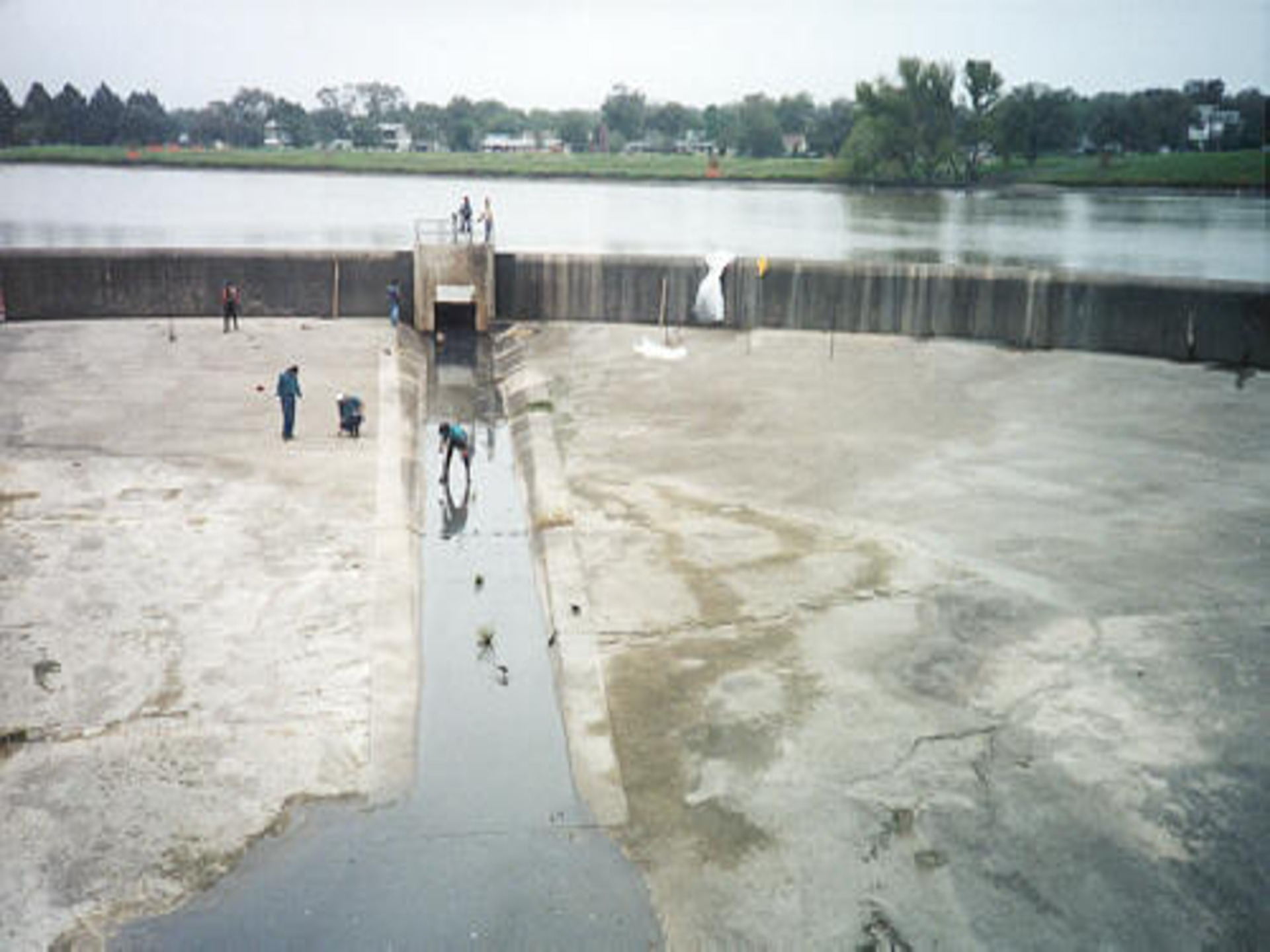
An overhead view of the spillway basin.
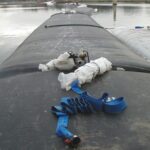
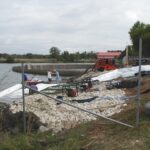


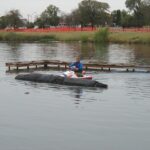

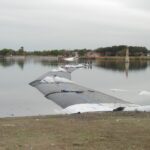
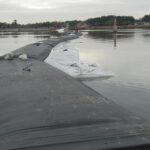
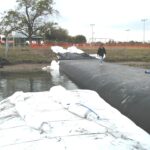
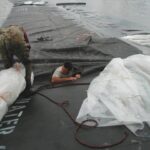
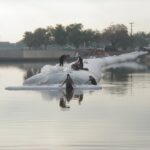
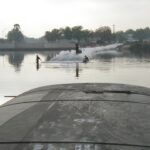
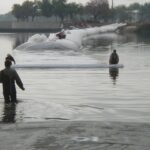

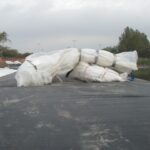
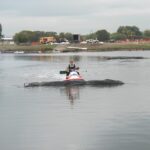

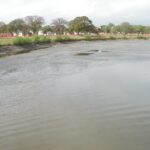

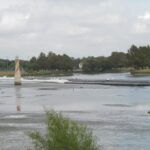
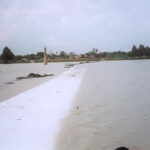
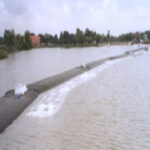
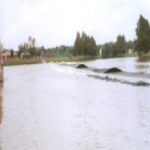

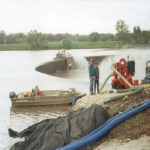
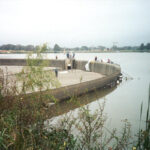
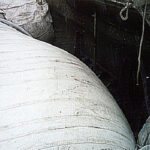

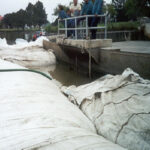
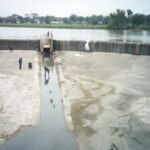
Multiple AquaDams, Woodlawn Lake, Shoreline Isolation, Sediment Removal, Two Projects
